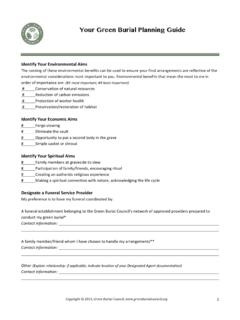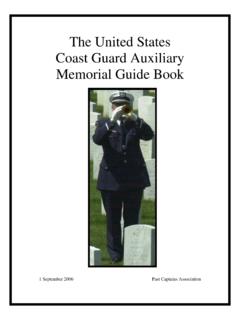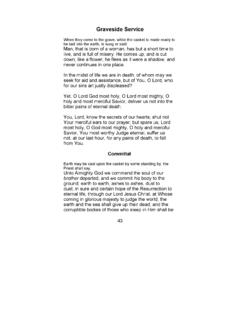Transcription of Green Burial Glossary
1 Glossary of Green Burial Terms Adapted vegetation: Non- invasive, beneficial plants (not noxious weeds) that have adapted to the specific locality; provides habitat and requires little or no maintenance. At need arrangements: Decisions and purchases made at the time of death rather than in advance, including selection of gravesite, Burial container, type of service, etc. (see also pre- need arrangements). Bier: A raised device or platform that holds the casket, either during a vigil or funeral service. Biodegradable containers: Caskets and shrouds capable of being decomposed by bacteria or other living organisms; often made of plant or animal fiber (wicker, sea grass, paper, linen, cotton, wool, willow, bamboo, etc.)
2 Metals, glues, resins, plastics and other synthetics are non- biodegradable. Blended funerals: Funerals that combine conventional funeral practices with home funeral and/or Green Burial practices; may include the use of a funeral director for certain aspects of care, such as obtaining, completing and filing paperwork or transporting the body. Families may have a home funeral without having a Green Burial and visa versa. Blended funerals offer families more options, especially when certain options are not available in their area. Burial density: The size, depth, ratio and distance of Burial plots from each other in an acre of cemetery.
3 Green Burial plots are typically much larger than conventional Burial plots and may accommodate the terrain rather than be laid out in rows. Burial density also indicates if more than one body may be buried in one plot over time (a practice that is common elsewhere in the world; see also serial Burial ). Caskets: Containers for the dead, previously called coffins. The terminology appears to have evolved as a marketing tool to emphasize the precious cargo. Casket (from Middle English casse, and Anglo- Norman French, cassette) was originally used to denote a small ornamental box, case, or chest for carrying jewels, letters or other valuable items.
4 Conventional caskets are built of steel, copper, and other metals, fiberglass, and exotic woods. Many are dressed with symbolic or religious icons, jewels, engravings, fittings, or trimming (fabric lining). Casket carts, carriages, or wagons: A non- motorized means of transporting the body to the gravesite. Celebrant: A professional trained in designing and officiating at customized ceremonies that reflect the needs, beliefs, and values of the person being honored. Many celebrants are trained in non- denominational and/or interfaith rituals. Many clergy are celebrants but not all celebrants are ordained clergy.
5 Cenotaph: A monument, wall, bench, stone, or other structure engraved with the name(s) of the dead; often placed in a central location in a cemetery and used in place of an individual grave marker. Copyright 2015, Green Burial Council, 1 Clergy: A person ordained to perform specific religious duties; the duties and titles vary among religions (minister, brother/sister, pastor, rector, priest, deacon, apostle, bishop, chaplain, rabbi, etc.) Coffins: Six- or eight- sided containers for the dead used for Burial or cremation. Eight- sided coffins, also called toe- pinchers, may be designed to conserve wood or to emphasize the shape of the human inside (wide shoulders tapering to small feet).
6 Plain pine boxes tend to be thought of as coffins, though there is no limitation. Derived from the Greek word kophinos, meaning basket. Committal service: An elective ritual that occurs after a funeral service ideally at the graveside; literally committing the body or ashes to the earth and the care of God. Companion grave: A grave in which two bodies are buried side by side in the same unit. Conservation Burial Grounds: A type of Green cemetery that is established in conjunction with a conservation organization and provides perpetual protection of the land according to the conservation easement or deed restriction in place; the highest standard of Green Burial certified by the Green Burial Council.
7 Conventional cemetery: A cemetery that requires the use of a concrete or fiberglass grave liner and a hard- . bottom casket; also known as a lawn cemetery or a modern cemetery. Prior to the establishment of modern cemeteries, most Burial occurred in churchyards or on family land and was environmentally friendly. Modern cemetery requirements are dictated by convention rather than law. Cremation: The process of reducing the body of the deceased to bone fragments and ashes by the use of high heat; the cremation of an average body uses enough natural gas and electricity to produce 140 lbs.
8 Of CO2. Decomposition: The breakdown of the body by natural means (soil, water, heat and microbes in balance); natural decomposition, the goal of Green Burial , occurs when no chemicals or non- biodegradable elements (steel, resins, fabrics, cement vaults) impede the process or attempt to preserve the body. Dry ice: The solid form of carbon dioxide; may be used to cool and preserve a body temporarily during a home funeral (home vigil). Dry ice must be handled carefully to avoid skin burns and requires good ventilation due to off- gassing of CO2. Ecologically appropriate features: Natural, inanimate elements of the landscape such as rocks, water features, native or adapted vegetation, and un- vegetated ground.
9 Embalming: The process of removing blood and fluids from the dead body and inserting preservatives, surfactants, solvents, and coloration to slow decomposition and improve looks for a period of up to two weeks. Organs are punctured and drained of fluid with the use of a sharp instrument called a trocar; waste is disposed of in a standard septic system or municipal wastewater treatment plant. Embalming fluid: An array of chemicals, including benzene, methanol, ethyl alcohol, and ethylene glycol (antifreeze). Formaldehyde, which constitutes anywhere from 5 to 29% of the solution, is associated with Copyright 2015, Green Burial Council, 2 increased risk of ALS (Amyotrophic Lateral Sclerosis), leukemia, lymph hematopoietic malignancies, and brain cancer in embalmers.
10 Endowment funds: Funds required by most states for long- term cemetery maintenance; also called perpetual care funds. Fieldstone: A naturally formed stone harvested directly from the earth on or near the cemetery property; they may be engraved, left in their natural form on a grave surface, and not polished or set in footings. Geographic Information System (GIS): The system used to capture, track, and record grave locations by source data, including latitude, longitude and elevation coordinates. Global Positioning System (GPS): A radio navigation system utilizing satellites that is often used in Green cemeteries in lieu of monuments to establish and map grave location.











